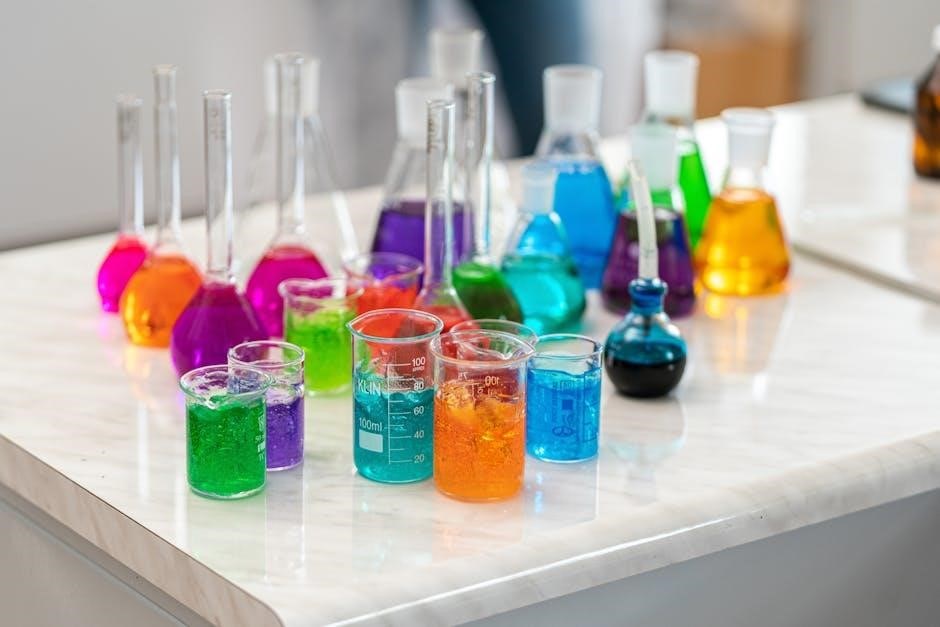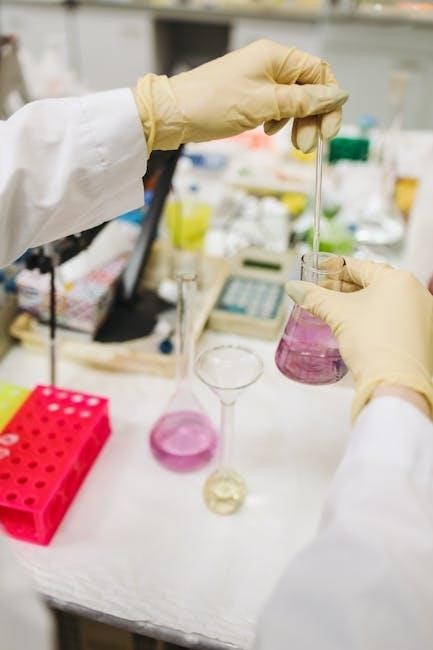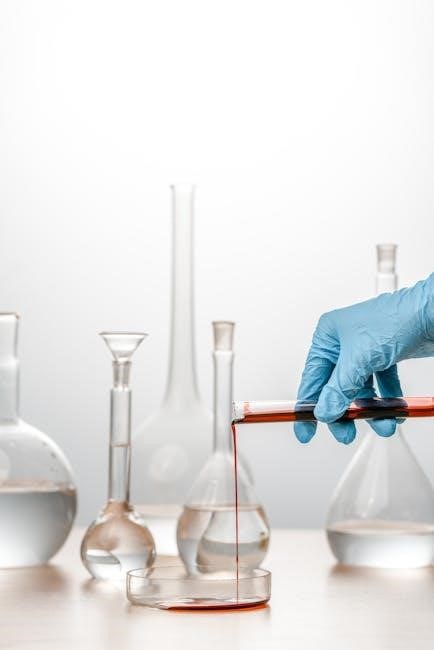Chemical reactions are fundamental processes where substances transform into new materials through chemical changes․ Understanding these reactions is essential for grasping chemistry’s role in transforming matter and energy․
Definition of Chemical Reactions
A chemical reaction is a process in which one or more substances, known as reactants, are transformed into new substances called products․ This transformation involves the breaking and forming of chemical bonds, resulting in changes to the chemical composition of the reactants․ A chemical reaction is characterized by a chemical equation, which uses symbols, formulas, and arrows to represent the reactants, products, and direction of the reaction․ Energy is often absorbed or released during this process, and the reaction may be accompanied by observable changes such as color, odor, or the release of gas․ Balanced chemical equations are essential for understanding these processes, as they show the conservation of mass and the stoichiometric relationships between reactants and products․
Importance of Understanding Chemical Reactions
Understanding chemical reactions is vital for grasping how matter transforms and energy is transferred․ These processes underpin advancements in medicine, environmental science, and technology․ By studying chemical reactions, students develop critical thinking and problem-solving skills, essential for STEM fields․ Chemical reactions explain natural phenomena and industrial processes, enabling the creation of new materials and medicines․ Balanced equations and stoichiometry are fundamental concepts that help predict reaction outcomes․ This knowledge empowers individuals to make informed decisions about energy use, sustainability, and resource management․ Additionally, it fosters curiosity about the molecular world, preparing learners for future innovations and challenges in science and engineering․
Types of Chemical Reactions
Chemical reactions are classified into synthesis, decomposition, single replacement, double replacement, combustion, acid-base, and nuclear reactions․ Each type has distinct characteristics and significance in chemistry․
Synthesis Reactions

Synthesis reactions involve the combination of two or more reactants to form a single product․ They are represented by the general equation A + B → AB․ These reactions are fundamental in chemistry, illustrating how elements or compounds unite to create new substances․ A key characteristic is the formation of a more complex molecule from simpler ones․ For example, hydrogen and oxygen combine to form water (2H₂ + O₂ → 2H₂O), and sodium and chlorine form sodium chloride (2Na + Cl₂ → 2NaCl)․ Understanding synthesis reactions is crucial for identifying and predicting chemical transformations, making them a cornerstone of chemistry problem-solving in educational worksheets․
Decomposition Reactions
Decomposition reactions involve the breakdown of a single compound into two or more simpler substances․ The general form is AB → A + B․ These reactions often require energy input, such as heat or light․ A classic example is the decomposition of hydrogen peroxide into water and oxygen (2H₂O₂ → 2H₂O + O₂)․ Another example is the breakdown of calcium carbonate into calcium oxide and carbon dioxide (CaCO₃ → CaO + CO₂)․ Decomposition reactions are essential for understanding how complex molecules can be simplified into their constituent elements or smaller compounds․ They are widely used in industrial processes and laboratory experiments, making them a key focus in chemistry education and problem-solving exercises․
Single Replacement Reactions
Single replacement reactions involve one element displacing another element from a compound․ The general form is A + BC → AC + B, where A and B are elements, and BC and AC are compounds․ These reactions typically require A to be more reactive than B․ A common example is when zinc reacts with copper sulfate solution, producing zinc sulfate and copper (Zn + CuSO₄ → ZnSO₄ + Cu)․ Another example is when iron reacts with hydrochloric acid to form iron chloride and hydrogen gas (Fe + 2HCl → FeCl₂ + H₂)․ These reactions highlight the role of reactivity in predicting reaction outcomes․ They are often used to study periodic trends and chemical reactivity in educational settings․
Double Replacement Reactions
Double replacement reactions occur when two compounds exchange their constituent elements, resulting in the formation of two new compounds․ The general form is AB + CD → AC + BD․ A classic example is the reaction between sodium hydroxide (NaOH) and sulfuric acid (H₂SO₄), which produces sodium sulfate (Na₂SO₄) and water (H₂O)․ Another example is the reaction between ammonium nitrate (NH₄NO₃) and barium chloride (BaCl₂), yielding ammonium chloride (NH₄Cl) and barium nitrate (Ba(NO₃)₂)․ These reactions often occur in aqueous solutions and can produce precipitates if one of the products is insoluble․ Double replacement reactions are essential in various chemical applications, including water softening and laboratory experiments, and they require careful consideration of solubility rules and stoichiometric balancing․

Combustion Reactions
Combustion reactions involve the reaction of a substance with oxygen, typically from the air, producing heat and light․ A common example is the burning of hydrocarbons, such as methane (CH₄) or gasoline, which react with oxygen (O₂) to form carbon dioxide (CO₂) and water (H₂O)․ The general form is:
Hydrocarbon + Oxygen → Carbon Dioxide + Water
These reactions are exothermic, releasing energy in the form of heat and light․ Combustion is essential in various industrial processes, transportation, and everyday applications like heating and cooking․ Understanding combustion reactions is crucial for developing efficient energy systems and reducing environmental impacts, such as air pollution from fossil fuel combustion․
Acid-Base Reactions
Acid-base reactions involve the reaction of an acid and a base to form a salt and water․ These reactions are fundamental in chemistry and occur in various natural and industrial processes․ The general form of an acid-base reaction is:
Acid + Base → Salt + Water
For example, hydrochloric acid (HCl) reacting with sodium hydroxide (NaOH) produces sodium chloride (NaCl) and water (H₂O)․ Acid-base reactions are exothermic and often proceed to completion․ They are essential in neutralization processes, such as treating acidic or basic spills, and in manufacturing industries for producing various chemicals and materials․
Nuclear Reactions
Nuclear reactions involve changes to the nucleus of an atom, unlike chemical reactions, which only affect electrons․ These reactions include fission, fusion, and radioactive decay․ In fission, a heavy nucleus splits into smaller nuclei, releasing energy, as seen in nuclear power plants․ Fusion combines two light nuclei to form a heavier nucleus, releasing vast energy, such as in the sun․ Radioactive decay involves unstable isotopes emitting radiation to become stable․ These reactions are central to energy production and scientific research, though they pose risks like radiation exposure and nuclear waste․ Understanding nuclear reactions is crucial for advancing technology and safety measures․ They differ fundamentally from chemical reactions in their energy scales and processes․

Key Characteristics of Each Reaction Type
Each reaction type has unique traits, such as synthesis combining substances, decomposition breaking them down, and combustion involving oxygen․ These characteristics aid in identifying and solving problems․
1․1․ Characteristics of Synthesis Reactions
Synthesis reactions involve the combination of two or more reactants to form a single product․ They are also known as combination reactions․ A key characteristic is the formation of a new compound from simpler substances․ These reactions often release energy, such as heat or light․ For example, the combination of iron and oxygen forms rust, while water is created from hydrogen and oxygen․ Synthesis reactions follow the general pattern: A + B → AB․ They are fundamental in chemistry, serving as the basis for creating many compounds, such as water and ammonia․ Understanding synthesis reactions is essential for solving problems related to chemical bonding and molecular formation․
1․2․ Characteristics of Decomposition Reactions

Decomposition reactions involve the breakdown of a single compound into two or more simpler substances․ Unlike synthesis reactions, decomposition reactions require an energy input, such as heat, light, or electricity․ They are the reverse of combination reactions, following the general pattern: AB → A + B․ A key characteristic is the separation of a compound into its constituent elements or simpler compounds․ For example, hydrogen peroxide decomposes into water and oxygen when exposed to heat․ These reactions are essential in natural processes, such as digestion, and in industrial applications, like the electrolysis of water․ They often release or absorb energy, making them vital for understanding chemical transformations and equilibrium․
1․3․ Characteristics of Single Replacement Reactions
Single replacement reactions involve one element displacing another from a compound, following the general form: A + BC → AC + B․ These reactions typically occur when a more reactive element replaces a less reactive one․ For instance, zinc reacts with hydrochloric acid to produce zinc chloride and hydrogen gas․ A key characteristic is the involvement of a free element and a compound, resulting in the formation of a new compound and a different free element․ The reactivity series is crucial in predicting these reactions, as more reactive elements can displace less reactive ones․ These reactions are fundamental in understanding chemical reactivity and are commonly used in industrial processes and laboratory experiments․
1․4․ Characteristics of Double Replacement Reactions

Double replacement reactions occur when two compounds exchange their ions to form two new compounds․ The general form is AB + CD → AC + BD․ These reactions typically happen in aqueous solutions, where the reactants are soluble, and one or both products are insoluble (precipitate), gases, or water․ A key characteristic is the swapping of cations and anions between the reactants․ For example, calcium chloride reacting with sodium carbonate forms calcium carbonate (precipitate) and sodium chloride․ These reactions often result in the formation of a precipitate, gas, or water, making them identifiable in a laboratory setting․ They are essential in understanding ionic interactions and are widely used in chemical analysis and industrial processes․
1․5․ Characteristics of Combustion Reactions
Combustion reactions involve the reaction of a substance with oxygen, typically producing heat and light․ These reactions often result in the formation of carbon dioxide and water when hydrocarbons or organic compounds react with oxygen․ A key feature is the release of energy, making them exothermic․ Combustion reactions follow the general form: combustible + oxygen → oxidized products + energy․ For example, methane (CH₄) burning in oxygen produces CO₂ and H₂O․ These reactions are vital in energy production, transportation, and industrial processes․ They are also associated with fire and explosions, emphasizing their rapid nature and high-energy release․ Understanding combustion is crucial for applications like fuel efficiency and pollution control․
1․6․ Characteristics of Acid-Base Reactions
Acid-base reactions involve the transfer of protons (H⁺ ions) between substances, resulting in the formation of water and a salt․ These reactions typically occur in aqueous solutions and follow the general form: acid + base → salt + water․ For example, hydrochloric acid (HCl) reacting with sodium hydroxide (NaOH) produces sodium chloride (NaCl) and water (H₂O)․ Acid-base reactions are exothermic, releasing heat, and often reach completion quickly․ They are fundamental in understanding neutralization processes and pH changes․ These reactions are essential in chemistry, biology, and industrial applications, such as in laboratories, households, and environmental science․ They help explain how substances interact and neutralize each other․
1․7․ Characteristics of Nuclear Reactions
Nuclear reactions involve changes to the nucleus of an atom, unlike chemical reactions, which only alter electron configurations․ These reactions include processes like fission, fusion, and radioactive decay․ Fission involves the splitting of heavy nuclei, while fusion combines light nuclei to form a heavier nucleus․ Radioactive decay occurs when unstable isotopes emit radiation to achieve stability․ Nuclear reactions release or absorb significant energy due to changes in mass, governed by Einstein’s equation E=mc²․ They often produce new atoms and a large amount of energy, making them crucial for applications like nuclear power and atomic bombs․ These reactions are central to understanding the structure and energy of matter․

Importance of Worksheets in Learning Chemical Reactions
Worksheets are essential for actively learning chemical reactions․ They aid in mastering reaction types, improving problem-solving skills, and enhancing conceptual retention․ They also provide practical applications effectively․

Improving Problem-Solving Skills
Worksheets on chemical reactions enhance problem-solving abilities by presenting diverse scenarios․ Students learn to analyze reactants, predict products, and balance equations, fostering critical thinking․ Regular practice strengthens their understanding of reaction mechanisms and types, enabling them to apply concepts to unfamiliar problems․ Interactive exercises encourage logical reasoning and precision, essential for mastering chemistry․ By solving structured problems, learners develop confidence and proficiency in tackling complex reactions․ Worksheets also provide immediate feedback, helping students identify and correct mistakes․ This iterative process improves analytical skills, preparing them for advanced chemical challenges and real-world applications․
Enhancing Understanding of Reaction Types
Worksheets on chemical reactions help students distinguish between various reaction types, such as synthesis, decomposition, and replacement reactions․ By categorizing and analyzing reactions, learners gain clarity on the unique characteristics of each type; Interactive exercises and examples enable students to recognize patterns and understand how reactants transform into products․ Visual aids like diagrams and equations further simplify complex concepts․ Practical examples and real-world applications reinforce theoretical knowledge, making it easier to grasp the differences between reaction types․ This structured approach ensures a deeper comprehension, helping students apply their knowledge to identify and classify reactions accurately in various contexts․
Practical Applications of Chemical Reactions
Understanding chemical reactions through worksheets provides students with insights into their practical applications in various industries and everyday life․ For instance, synthesis reactions are fundamental in manufacturing chemicals and pharmaceuticals, while decomposition reactions are crucial in processes like nuclear energy․ Single and double replacement reactions are essential in water treatment and metallurgy․ Combustion reactions are vital in energy production, such as in power plants and vehicles․ Acid-base reactions are integral to food production and household cleaning products․ By studying these real-world connections, students appreciate how chemical reactions solve problems and drive innovation, making their learning experience more relevant and engaging․
Interactive Learning Through Worksheets
Worksheets offer an interactive and engaging way for students to explore chemical reactions․ Through hands-on activities, such as identifying reaction types, balancing equations, and predicting products, students develop a deeper understanding of concepts․ Interactive exercises, like matching reaction types to their descriptions or completing fill-in-the-blank problems, make learning dynamic․ Visual elements, such as diagrams and flowcharts, enhance comprehension․ Worksheets also encourage self-assessment, allowing students to track their progress and identify areas for improvement․ By actively participating in problem-solving, students build critical thinking skills and retain information more effectively․ This interactive approach fosters a more enjoyable and effective learning experience compared to passive methods․
How to Answer Chemical Reactions Worksheet Questions
Mastering chemical reactions requires a systematic approach․ Start by carefully reading each question, identifying the reaction type, and balancing equations when necessary․ Use provided data and periodic tables to predict products․ Practice regularly and review mistakes to improve accuracy․ Utilize online resources like worksheets and tutorials for additional support․ Always double-check your work to ensure completeness and correctness․ This methodical strategy helps build confidence and proficiency in solving chemical reaction problems effectively․
Identifying Reaction Types
Identifying reaction types is the first step in solving chemical reaction problems․ Start by analyzing the reactants and products to determine the reaction category․ Synthesis reactions combine two substances to form a single product, while decomposition reactions break one substance into two or more․ Single replacement reactions involve one element displacing another, and double replacement reactions swap ions between compounds․ Combustion reactions typically involve a substance reacting with oxygen to produce heat and light․ Acid-base reactions result in the formation of water and a salt․ Nuclear reactions involve changes to the nucleus of an atom․ Understanding these patterns helps in categorizing reactions accurately․
Balancing Chemical Equations
Balancing chemical equations is a critical skill in chemistry, ensuring the law of conservation of mass is upheld․ Start by counting the number of atoms of each element on both sides․ Identify which elements are unequal and add coefficients (numbers in front of formulas) to balance them․ Begin with elements that appear only once, as they are often the key to balancing․ Use fractions if necessary, but multiply through to eliminate them․ Ensure polyatomic ions are treated as single units․ Finally, double-check by recounting atoms and verifying charges for ions․ A balanced equation accurately reflects the mole ratios of reactants and products, essential for stoichiometric calculations․
Predicting Products of Reactions
Predicting the products of chemical reactions involves identifying the reaction type and applying specific rules․ For synthesis reactions, two reactants combine to form a single product․ Decomposition reactions break one compound into two or more simpler substances․ In single replacement reactions, a more reactive element displaces another from a compound․ Double replacement reactions involve the exchange of ions between two compounds, forming two new compounds․ Combustion reactions typically produce carbon dioxide and water when hydrocarbons react with oxygen․ Acid-base reactions yield a salt and water․ To predict products, recognize the reaction type, apply solubility rules for precipitation, and use the periodic table for reactivity trends․ Practice and understanding reaction mechanisms enhance accuracy․
Avoiding Common Mistakes
Avoiding common mistakes when solving chemical reactions worksheets requires attention to detail and a systematic approach․ One frequent error is misidentifying the reaction type, leading to incorrect predictions․ Always classify reactions carefully, such as synthesis, decomposition, or replacement․ Another mistake is forgetting to balance chemical equations, which is crucial for determining products․ Students often overlook stoichiometry or fail to account for all atoms․ Additionally, incorrect use of solubility rules in double replacement reactions can result in wrong products․ Carelessly writing chemical formulas, such as reversing reactants or products, is another pitfall․ To avoid these errors, double-check each step, use reference tables, and practice regularly to improve accuracy and speed․

Benefits of Using PDF Worksheets
Pdfs provide portability, easy sharing, and consistent formatting․ Accessible on multiple devices, they are environmentally friendly and professionally designed for efficient and effective chemical learning․

Accessibility and Convenience
PDF worksheets offer unparalleled accessibility and convenience for learning chemical reactions․ They can be easily downloaded, viewed, and printed from any device with a PDF reader․ Students can access them offline, making them ideal for study sessions without internet connectivity․ PDFs are also shareable via email, cloud storage, or learning management systems, ensuring that everyone in a class or study group can access the same materials․ Additionally, PDFs are compatible with multiple devices, from smartphones to tablets and desktops, allowing learners to study chemical reactions anywhere, anytime․ This flexibility enhances the overall learning experience, making it easier to master complex topics like synthesis and decomposition reactions․
Environmentally Friendly Option
Using PDF worksheets for learning chemical reactions is an environmentally friendly option․ PDFs reduce the need for physical paper, conserving trees and minimizing waste․ By storing and sharing worksheets digitally, the carbon footprint associated with printing and transporting materials is significantly lowered․ This eco-conscious approach aligns with modern sustainability goals․ Additionally, PDFs eliminate the need for repetitive printing, further reducing resource consumption․ Students and educators can access and reuse these worksheets without contributing to environmental degradation․ This makes PDF worksheets a responsible choice for learning chemical reactions while promoting greener study habits․ Their digital nature supports sustainable education without compromising on quality or accessibility․
Easy to Share and Distribute
PDF worksheets for chemical reactions are incredibly easy to share and distribute․ They can be sent via email, uploaded to cloud storage, or shared through learning management systems․ This makes it simple for educators to provide materials to students, regardless of their location․ PDFs are universally compatible, ensuring that anyone with a device can open and view them without needing specialized software․ This convenience fosters collaboration and accessibility, allowing students to access worksheets anytime, anywhere․ Additionally, PDFs eliminate the need for physical copies, saving time and effort for both teachers and learners․ Their ease of sharing makes PDF worksheets a practical choice for modern education․
Professional Formatting and Layout
PDF worksheets for chemical reactions are designed with professional formatting and layout, ensuring clarity and readability․ The structured organization of content, including clear headings, bullet points, and diagrams, enhances the learning experience․ Fonts and spacing are optimized for readability, while tables and reaction schemes are presented in a visually appealing manner․ This professional presentation helps students focus on the subject matter without distractions․ Additionally, consistent formatting across worksheets aids in building familiarity, making it easier for students to navigate and understand complex chemical concepts․ The polished appearance of PDF worksheets also adds credibility, making them a valuable resource for educational purposes․
Chemical reactions are fundamental to understanding chemistry, and worksheets are invaluable tools for mastering reaction types․ PDF resources provide comprehensive answers, enhancing problem-solving skills and conceptual clarity․ By practicing synthesis, decomposition, single and double replacement, combustion, acid-base, and nuclear reactions, students gain a solid foundation․ These worksheets also emphasize balancing equations, predicting products, and avoiding common errors․ Regular practice fosters confidence and prepares learners for advanced topics․ Utilizing PDF worksheets ensures accessibility, organization, and eco-friendly learning․ Overall, dedicated practice with these resources is essential for excelling in chemistry and applying knowledge to real-world scenarios effectively․
Encouragement for Further Study
Mastering chemical reactions opens doors to deeper understanding and application in science․ With a strong foundation from worksheets, students are encouraged to explore advanced topics like organic chemistry or biochemistry․ Engaging in regular practice with PDF resources enhances critical thinking and problem-solving abilities․ Encourage learners to apply theoretical knowledge to real-world scenarios, such as environmental science or industrial processes․ Pursuing additional study materials and online courses can further refine skills․ By embracing continuous learning, students can unlock the full potential of chemistry and contribute to innovative solutions in various fields․ Keep exploring, practicing, and pushing boundaries to achieve excellence in this fascinating subject․